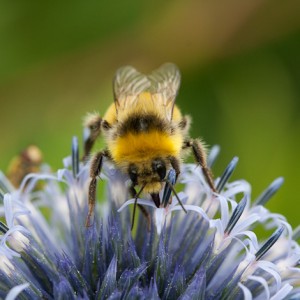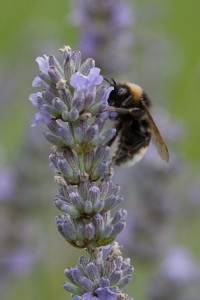I joined the Bumblebee Conservation Trust last year following a Summer trying to photograph them which made me realise how interesting and different they all were. Couple that with all of the coverage regarding the plight of the honeybee which also extends, although for different reasons, to other pollinators, and I decided that it was time I discovered more about the bees in my garden.
Fast forward a year and with my new found interest in invertebrates I started to discover there were more bees about than I had realised, including my favourite, the red-tailed bumblebee, and others such as the wonderfully named hairy footed flower bee. Despite many attempts and lots of photos, I still felt at a loss when it came to positively identifying them. When I saw an advert for a bumblebee identification session at Leicester University on a Sunday afternoon then I signed up straight away.
 I arrived early and thought I would go and try and find some bees to photograph – as you would (and, amazingly, got some photos I was really pleased with). They had some lavender beds in their herb garden which we literally buzzing as well as some other plant such as echinops which also seemed pretty popular.
I arrived early and thought I would go and try and find some bees to photograph – as you would (and, amazingly, got some photos I was really pleased with). They had some lavender beds in their herb garden which we literally buzzing as well as some other plant such as echinops which also seemed pretty popular.
Anyway, back to the course. It was run by a lovely lady called Maggie, who is obviously obsessed by bees. She went through the lifecycle of bees, some of the differences between them and included a list of plants that she had created and which she had subsequently grouped according to how many species of bee visited them. I came away realising that I had to be a little more choosy about the plants that I am putting in the garden and with some ideas for research that I could also undertake. First, however, I need to be able to identify them.
I was hoping to come away from a couple of hours amongst the flowers with the ability to recognise the common bumbles, the big six. But, there are queens, workers and males – so the big six became 18, and then there are the cuckoo bumble bees – another 4 types with males and females so we are now at 26! Suddenly it was not as easy as I had hoped. (Cuckoo bumbles don’t need workers as they parasitise the nests of particular bumbles so use their workers to care for their offspring.) Then, as the bees get older, just like us they fade and get greyer, well, paler – so then all the descriptions seem to go out of the window!
 Did I come away knowing many of the 26? Well, we did find four of the big six – but they are mainly males and workers at this time of year, the queens are in the nests. So, I can recognise a carder bee (a little fluffy, ginger bee), and the red-tailed bumble bee, I will also have a go at the buff and white tailed bees (the male white-tailed bumble bees are particularly lovely – see photo above), but we didn’t see the early or garden bumblebees, so I will carry on looking. However, we did find three or four species of cuckoo bee, which I may have seen before and just not realised what they were (such as the one in the photo on the right)! So, although I am not fully convinced that I can get the big six yet, I have now a better idea, and think I can have a go at finding cuckoo bees. I will also be planning some winter research and some more bee-friendly plants for next year.
Did I come away knowing many of the 26? Well, we did find four of the big six – but they are mainly males and workers at this time of year, the queens are in the nests. So, I can recognise a carder bee (a little fluffy, ginger bee), and the red-tailed bumble bee, I will also have a go at the buff and white tailed bees (the male white-tailed bumble bees are particularly lovely – see photo above), but we didn’t see the early or garden bumblebees, so I will carry on looking. However, we did find three or four species of cuckoo bee, which I may have seen before and just not realised what they were (such as the one in the photo on the right)! So, although I am not fully convinced that I can get the big six yet, I have now a better idea, and think I can have a go at finding cuckoo bees. I will also be planning some winter research and some more bee-friendly plants for next year.